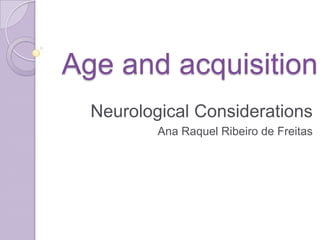
Ageandacquisitionnew
- 1. Age and acquisition Neurological Considerations Ana Raquel Ribeiro de Freitas
- 2. Does the maturation of the brain at some stage show the failure of language acquisition ability? How might neurological development affect Second language success?
- 3. As the brain matures, certain functions are assigned to either the left or right hemisphere. Some scholars have singled out the lateralization of the brain as the key for answering such question.
- 4. So language functions appear to be controlled mainly in the left hemisphere, though there is good deal of conflicting evidence. Hemispherectomies- capable to produce language Stroke or accident in the left side- laguage impairment
- 5. Neurobiological considerations Hemispheric lateralization – when lateralization takes place Lenneberg (1967) Lateralization begins at around 2 and is completed around puberty Geschwind (1970) Lateralization Is completed much earlier Krashen (1973) Lateralization Is completed at 5 years old Scovel (1984) Lateralization emerges at birth is evident at 5 is completed at around puberty
- 6. Scovel also proposed that there is a relationship between lateralization and second language acquisition. He suggested that the plasticity of the brain prior to puberty enables children to acquire not only their first language but also a second language- and that is possibly what makes difficult for na adult to acquire fluent control of second language or at least to acquire it without the what Guiora call “authentic”(nativelike) pronunciation.
- 7. In 1988, Scovel also suggested the possibility of a critical period not only for first language but also for second language acquisition. One the most complelling arguments for a accent related critical period was the evidence of sociobiological critical period in various species Sociobiological critical period mammals birds human beings?
- 8. (1) To form an identity with their own community as they anticipate roles of parenting and leadership (2) To attract mates of “their own kind” in an instinctive drive to maintain their own specie. Walsh and Diller(1981) : concluded that different aspects of a second language are learned optimally at different ages. Lower order process such as pronunciation are depending on early maturing and less adaptative macroneural circuits- which makes foreign accents more difficult to overcome after childhood. High- order language functions such as semantic relation are more dependent on late maturing neural circuits. That sociobiological evidence persuades us to conclude that native accents and therefore foreign accentes after puberty maybe genetic leftover which, in our widespread human pratice of mating across dialectal linguistic, and racial barrier, is no longuer necessary for the preservations of human species.
- 9. Right-Hemispheric Participation There is a significant right hemispheric participation particularly in early stages of language learning Obler (1981) Genesee (1982) Scovel (1982) supported did not support “There may be greater right hemisphere involvement in language process in bilinguals who acquire their second language late relative to their first language and bilinguals who learn it in informal contexts Conflicting evidence
- 10. Sorenson (1967) “The Language acquisition seen in adult language learners in the largely monolingual American middle class speech communities may have been inappropriately taken to be universal…” (Hill, 1970) So how some adults have been know to acquire na authentic accent in a second language after the age of puberty? Hill Response to Scovel study – antropological research on non-western societies where adultss can in the normal course of their lifes acquire second language perfectly. Tukanos tribes of south Africa- at least two dozens languages are spoken among this tribes- people marry outside their group- adolecents can speaks 02 or 3 languages they are sposed to. In adulthood they may acquire more languages.
- 11. Today researchers are continuing to quest for answers to child-adult differences, by looking beyond neurological factors Fledge and Morris for example cites motivation, affective variables , social factors that can also influence that kind of acquisition.
- 12. Thanks References Douglas Brown, H. (2007) Principles of language learning and teaching. White Plains, NY: Longman. Chapter 3: Age & acquisition
